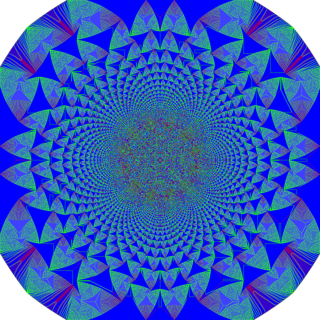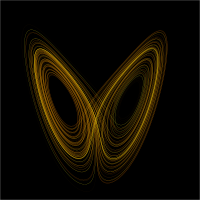
Chaos theory is an interdisciplinary area of scientific study and branch of mathematics. It focuses on underlying patterns and deterministic laws of dynamical systems that are highly sensitive to initial conditions. These were once thought to have completely random states of disorder and irregularities. Chaos theory states that within the apparent randomness of chaotic complex systems, there are underlying patterns, interconnection, constant feedback loops, repetition, self-similarity, fractals and self-organization. The butterfly effect, an underlying principle of chaos, describes how a small change in one state of a deterministic nonlinear system can result in large differences in a later state. A metaphor for this behavior is that a butterfly flapping its wings in Texas can cause a tornado in Brazil.

Social dynamics is the study of the behavior of groups and of the interactions of individual group members, aiming to understand the emergence of complex social behaviors among microorganisms, plants and animals, including humans. It is related to sociobiology but also draws from physics and complex system sciences. In the last century, sociodynamics was viewed as part of psychology, as shown in the work: "Sociodynamics: an integrative theorem of power, authority, interfluence and love". In the 1990s, social dynamics began being viewed as a separate scientific discipline[By whom?]. An important paper in this respect is: "The Laws of Sociodynamics". Then, starting in the 2000s, sociodynamics took off as a discipline of its own, many papers were released in the field in this decade.

In philosophy, systems theory, science, and art, emergence occurs when a complex entity has properties or behaviors that its parts do not have on their own, and emerge only when they interact in a wider whole.
Predictability is the degree to which a correct prediction or forecast of a system's state can be made, either qualitatively or quantitatively.

Self-organization, also called spontaneous order in the social sciences, is a process where some form of overall order arises from local interactions between parts of an initially disordered system. The process can be spontaneous when sufficient energy is available, not needing control by any external agent. It is often triggered by seemingly random fluctuations, amplified by positive feedback. The resulting organization is wholly decentralized, distributed over all the components of the system. As such, the organization is typically robust and able to survive or self-repair substantial perturbation. Chaos theory discusses self-organization in terms of islands of predictability in a sea of chaotic unpredictability.
Econophysics is a non-orthodox interdisciplinary research field, applying theories and methods originally developed by physicists in order to solve problems in economics, usually those including uncertainty or stochastic processes and nonlinear dynamics. Some of its application to the study of financial markets has also been termed statistical finance referring to its roots in statistical physics. Econophysics is closely related to social physics.

Self-organized criticality (SOC) is a property of dynamical systems that have a critical point as an attractor. Their macroscopic behavior thus displays the spatial or temporal scale-invariance characteristic of the critical point of a phase transition, but without the need to tune control parameters to a precise value, because the system, effectively, tunes itself as it evolves towards criticality.

Dynamical systems theory is an area of mathematics used to describe the behavior of complex dynamical systems, usually by employing differential equations or difference equations. When differential equations are employed, the theory is called continuous dynamical systems. From a physical point of view, continuous dynamical systems is a generalization of classical mechanics, a generalization where the equations of motion are postulated directly and are not constrained to be Euler–Lagrange equations of a least action principle. When difference equations are employed, the theory is called discrete dynamical systems. When the time variable runs over a set that is discrete over some intervals and continuous over other intervals or is any arbitrary time-set such as a Cantor set, one gets dynamic equations on time scales. Some situations may also be modeled by mixed operators, such as differential-difference equations.
A complex adaptive system is a system that is complex in that it is a dynamic network of interactions, but the behavior of the ensemble may not be predictable according to the behavior of the components. It is adaptive in that the individual and collective behavior mutate and self-organize corresponding to the change-initiating micro-event or collection of events. It is a "complex macroscopic collection" of relatively "similar and partially connected micro-structures" formed in order to adapt to the changing environment and increase their survivability as a macro-structure. The Complex Adaptive Systems approach builds on replicator dynamics.
A Boolean Delay Equation (BDE) is an evolution rule for the state of dynamical variables whose values may be represented by a finite discrete numbers os states, such as 0 and 1. As a novel type of semi-discrete dynamical systems, Boolean delay equations (BDEs) are models with Boolean-valued variables that evolve in continuous time. Since at the present time, most phenomena are too complex to be modeled by partial differential equations (as continuous infinite-dimensional systems), BDEs are intended as a (heuristic) first step on the challenging road to further understanding and modeling them. For instance, one can mention complex problems in fluid dynamics, climate dynamics, solid-earth geophysics, and many problems elsewhere in natural sciences where much of the discourse is still conceptual.
Complexity theory and organizations, also called complexity strategy or complex adaptive organizations, is the use of the study of complexity systems in the field of strategic management and organizational studies. It draws from research in the natural sciences that examines uncertainty and non-linearity. Complexity theory emphasizes interactions and the accompanying feedback loops that constantly change systems. While it proposes that systems are unpredictable, they are also constrained by order-generating rules.
Complexity economics is the application of complexity science to the problems of economics. It relaxes several common assumptions in economics, including general equilibrium theory. While it does not reject the existence of an equilibrium, it sees such equilibria as "a special case of nonequilibrium", and as an emergent property resulting from complex interactions between economic agents. The complexity science approach has also been applied to computational economics.

A Boolean network consists of a discrete set of boolean variables each of which has a Boolean function assigned to it which takes inputs from a subset of those variables and output that determines the state of the variable it is assigned to. This set of functions in effect determines a topology (connectivity) on the set of variables, which then become nodes in a network. Usually, the dynamics of the system is taken as a discrete time series where the state of the entire network at time t+1 is determined by evaluating each variable's function on the state of the network at time t. This may be done synchronously or asynchronously.
An ecological network is a representation of the biotic interactions in an ecosystem, in which species (nodes) are connected by pairwise interactions (links). These interactions can be trophic or symbiotic. Ecological networks are used to describe and compare the structures of real ecosystems, while network models are used to investigate the effects of network structure on properties such as ecosystem stability.
George Sugihara is currently a professor of biological oceanography in the Physical Oceanography Research Division at the Scripps Institution of Oceanography, where he is the inaugural holder of the McQuown Chair in Natural Science. Sugihara is a theoretical biologist who works across a variety of fields ranging from ecology and landscape ecology, to epidemiology, to genetics, to geoscience and atmospheric science, to quantitative finance and economics.
A coupled map lattice (CML) is a dynamical system that models the behavior of nonlinear systems. They are predominantly used to qualitatively study the chaotic dynamics of spatially extended systems. This includes the dynamics of spatiotemporal chaos where the number of effective degrees of freedom diverges as the size of the system increases.

The Rulkov map is a two-dimensional iterated map used to model a biological neuron. It was proposed by Nikolai F. Rulkov in 2001. The use of this map to study neural networks has computational advantages because the map is easier to iterate than a continuous dynamical system. This saves memory and simplifies the computation of large neural networks.

Jürgen Kurths is a German physicist and mathematician. He is senior advisor in the research department Complexity Sciences of the Potsdam Institute for Climate Impact Research, a Professor of Nonlinear Dynamics at the Institute of Physics at the Humboldt University, Berlin, and a 6th-century chair for Complex Systems Biology at the Institute for Complex Systems and Mathematical Biology at Kings College, Aberdeen University (UK). His research is mainly concerned with nonlinear physics and complex systems sciences and their applications to challenging problems in Earth system, physiology, systems biology and engineering.

Edward Ott is an American physicist most noted for his contributions to the development of chaos theory.
Critical transitions are abrupt shifts in the state of ecosystems, the climate, financial systems or other complex dynamical systems that may occur when changing conditions pass a critical or bifurcation point. As such, they are a particular type of regime shift. Recovery from such shifts may require more than a simple return to the conditions at which a transition occurred, a phenomenon called hysteresis. In addition to natural systems, critical transitions are also studied in psychology, medicine, economics, sociology, military, and several other disciplines.











